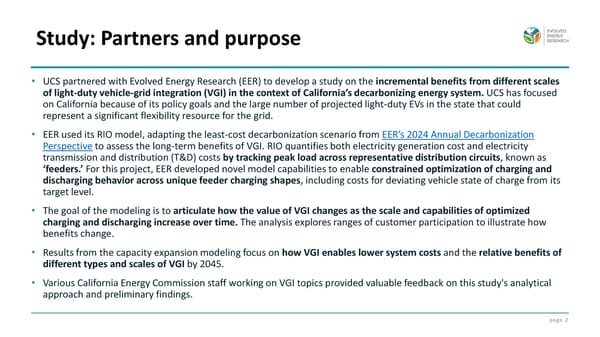page 2 • UCS partnered with Evolved Energy Research (EER) to develop a study on the incremental benefits from different scales of light-duty vehicle-grid integration (VGI) in the context of California’s decarbonizing energy system. UCS has focused on California because of its policy goals and the large number of projected light-duty EVs in the state that could represent a significant flexibility resource for the grid. • EER used its RIO model, adapting the least-cost decarbonization scenario from EER’s 2024 Annual Decarbonization Perspective to assess the long-term benefits of VGI. RIO quantifies both electricity generation cost and electricity transmission and distribution (T&D) costs by tracking peak load across representative distribution circuits, known as ‘feeders.’ For this project, EER developed novel model capabilities to enable constrained optimization of charging and discharging behavior across unique feeder charging shapes, including costs for deviating vehicle state of charge from its target level. • The goal of the modeling is to articulate how the value of VGI changes as the scale and capabilities of optimized charging and discharging increase over time. The analysis explores ranges of customer participation to illustrate how benefits change. • Results from the capacity expansion modeling focus on how VGI enables lower system costs and the relative benefits of different types and scales of VGI by 2045. • Various California Energy Commission staff working on VGI topics provided valuable feedback on this study's analytical approach and preliminary findings. Study: Partners and purpose
 Exploring the Value of Vehicle to Grid (V2G) for California Page 1 Page 3
Exploring the Value of Vehicle to Grid (V2G) for California Page 1 Page 3